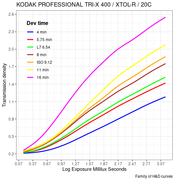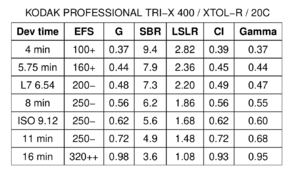aparat
Member
Well, it sure looks like Kodak is. The Eastman Kodak Company is still making a few of its famous Xes, including:
But before I show you the results of my analysis, I want to share some of my calibration data.
I run a calibration procedure before each film test. It involves exposing and developing a sample of the films under study four times to make sure that my process is reasonably consistent across trials, both in terms of exposure and development.
I exposed the EASTMAN DOUBLE-X 5222 and KODAK TRI-X 400 for the same amount of exposure and processed in the same Jobo 1510 tank by rotary agitation. To establish a baseline, I processed these calibration samples in stock XTOL (non-replenished) for 7 minutes at 20C.


I guess I overcooked the "green" development a bit, but, overall, the results show reasonable consistency. The curves of both films are well-formed, showing a long, smooth tonality and excellent tonal separation along virtually the entire range. Given enough exposure, these two films are obviously capable of excellent results. Yes, the two curve families have a slightly different overall shape, but it remains to be seen whether XTOL and XTOL-R differ in how they affect contrast, tonality and film speed.
More data coming soon. Your comments and suggestions are most appreciated!
- KODAK PROFESSIONAL XTOL Developer
- EASTMAN DOUBLE-X (5222), and
- KODAK PROFESSIONAL TRI-X 400 (400TX) black and white negative films.
But before I show you the results of my analysis, I want to share some of my calibration data.
I run a calibration procedure before each film test. It involves exposing and developing a sample of the films under study four times to make sure that my process is reasonably consistent across trials, both in terms of exposure and development.
I exposed the EASTMAN DOUBLE-X 5222 and KODAK TRI-X 400 for the same amount of exposure and processed in the same Jobo 1510 tank by rotary agitation. To establish a baseline, I processed these calibration samples in stock XTOL (non-replenished) for 7 minutes at 20C.


I guess I overcooked the "green" development a bit, but, overall, the results show reasonable consistency. The curves of both films are well-formed, showing a long, smooth tonality and excellent tonal separation along virtually the entire range. Given enough exposure, these two films are obviously capable of excellent results. Yes, the two curve families have a slightly different overall shape, but it remains to be seen whether XTOL and XTOL-R differ in how they affect contrast, tonality and film speed.
More data coming soon. Your comments and suggestions are most appreciated!





 .
. 









